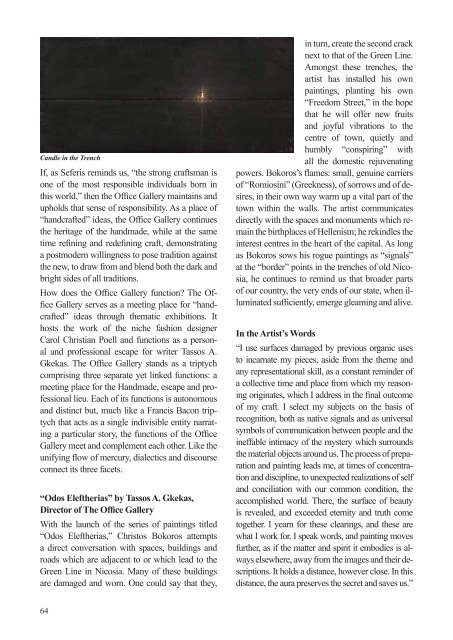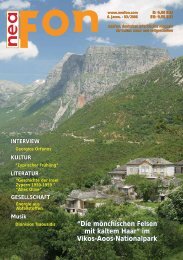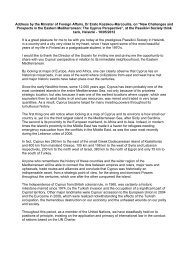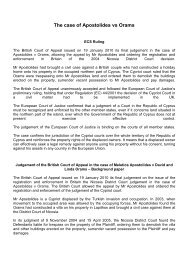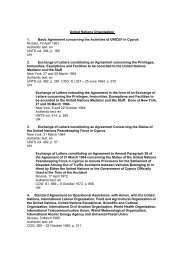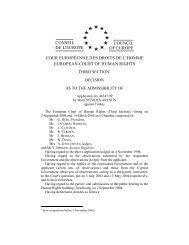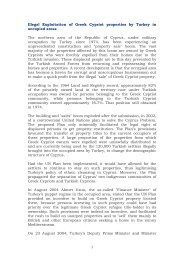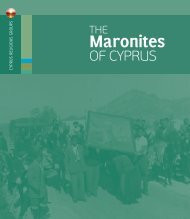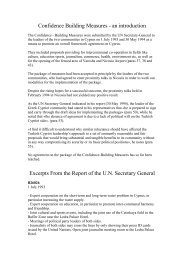Volume L, No 3, July-September 2012 - Ministry of Foreign Affairs
Volume L, No 3, July-September 2012 - Ministry of Foreign Affairs
Volume L, No 3, July-September 2012 - Ministry of Foreign Affairs
Create successful ePaper yourself
Turn your PDF publications into a flip-book with our unique Google optimized e-Paper software.
Candle in the Trench<br />
If, as Seferis reminds us, “the strong craftsman is<br />
one <strong>of</strong> the most responsible individuals born in<br />
this world,” then the Office Gallery maintains and<br />
upholds that sense <strong>of</strong> responsibility. As a place <strong>of</strong><br />
“handcrafted” ideas, the Office Gallery continues<br />
the heritage <strong>of</strong> the handmade, while at the same<br />
time refining and redefining craft, demonstrating<br />
a postmodern willingness to pose tradition against<br />
the new, to draw from and blend both the dark and<br />
bright sides <strong>of</strong> all traditions.<br />
How does the Office Gallery function? The Office<br />
Gallery serves as a meeting place for “handcrafted”<br />
ideas through thematic exhibitions. It<br />
hosts the work <strong>of</strong> the niche fashion designer<br />
Carol Christian Poell and functions as a personal<br />
and pr<strong>of</strong>essional escape for writer Tassos A.<br />
Gkekas. The Office Gallery stands as a triptych<br />
comprising three separate yet linked functions: a<br />
meeting place for the Handmade, escape and pr<strong>of</strong>essional<br />
lieu. Each <strong>of</strong> its functions is autonomous<br />
and distinct but, much like a Francis Bacon triptych<br />
that acts as a single indivisible entity narrating<br />
a particular story, the functions <strong>of</strong> the Office<br />
Gallery meet and complement each other. Like the<br />
unifying flow <strong>of</strong> mercury, dialectics and discourse<br />
connect its three facets.<br />
“Odos Eleftherias” by Tassos A. Gkekas,<br />
Director <strong>of</strong> The Office Gallery<br />
With the launch <strong>of</strong> the series <strong>of</strong> paintings titled<br />
“Odos Eleftherias,” Christos Bokoros attempts<br />
a direct conversation with spaces, buildings and<br />
roads which are adjacent to or which lead to the<br />
Green Line in Nicosia. Many <strong>of</strong> these buildings<br />
are damaged and worn. One could say that they,<br />
in turn, create the second crack<br />
next to that <strong>of</strong> the Green Line.<br />
Amongst these trenches, the<br />
artist has installed his own<br />
paintings, planting his own<br />
“Freedom Street,” in the hope<br />
that he will <strong>of</strong>fer new fruits<br />
and joyful vibrations to the<br />
centre <strong>of</strong> town, quietly and<br />
humbly “conspiring” with<br />
all the domestic rejuvenating<br />
powers. Bokoros’s flames: small, genuine carriers<br />
<strong>of</strong> “Romiosini” (Greekness), <strong>of</strong> sorrows and <strong>of</strong> desires,<br />
in their own way warm up a vital part <strong>of</strong> the<br />
town within the walls. The artist communicates<br />
directly with the spaces and monuments which remain<br />
the birthplaces <strong>of</strong> Hellenism; he rekindles the<br />
interest centres in the heart <strong>of</strong> the capital. As long<br />
as Bokoros sows his rogue paintings as “signals”<br />
at the “border” points in the trenches <strong>of</strong> old Nicosia,<br />
he continues to remind us that broader parts<br />
<strong>of</strong> our country, the very ends <strong>of</strong> our state, when illuminated<br />
sufficiently, emerge gleaming and alive.<br />
In the Artist’s Words<br />
“I use surfaces damaged by previous organic uses<br />
to incarnate my pieces, aside from the theme and<br />
any representational skill, as a constant reminder <strong>of</strong><br />
a collective time and place from which my reasoning<br />
originates, which I address in the final outcome<br />
<strong>of</strong> my craft. I select my subjects on the basis <strong>of</strong><br />
recognition, both as native signals and as universal<br />
symbols <strong>of</strong> communication between people and the<br />
ineffable intimacy <strong>of</strong> the mystery which surrounds<br />
the material objects around us. The process <strong>of</strong> preparation<br />
and painting leads me, at times <strong>of</strong> concentration<br />
and discipline, to unexpected realizations <strong>of</strong> self<br />
and conciliation with our common condition, the<br />
accomplished world. There, the surface <strong>of</strong> beauty<br />
is revealed, and exceeded eternity and truth come<br />
together. I yearn for these clearings, and these are<br />
what I work for. I speak words, and painting moves<br />
further, as if the matter and spirit it embodies is always<br />
elsewhere, away from the images and their descriptions.<br />
It holds a distance, however close. In this<br />
distance, the aura preserves the secret and saves us.”<br />
64


